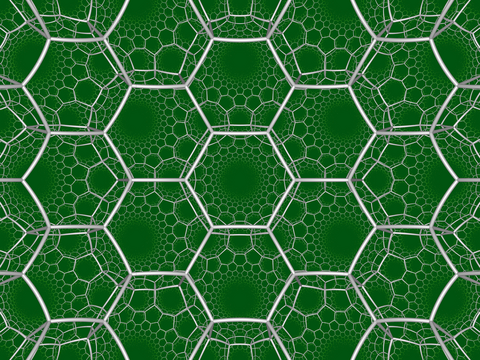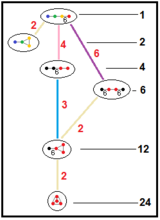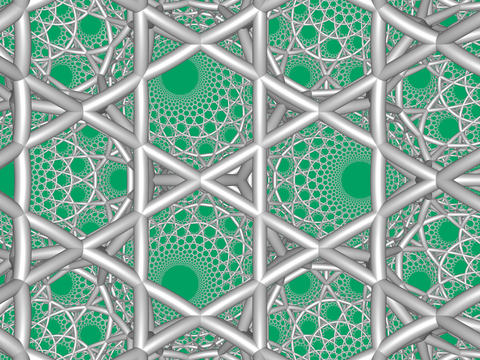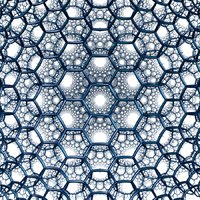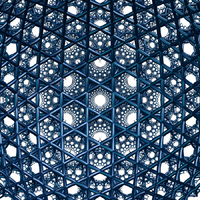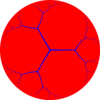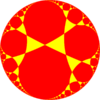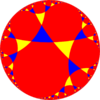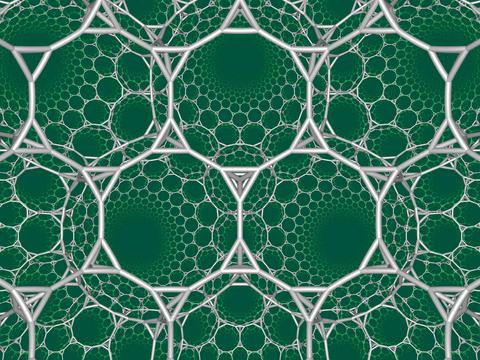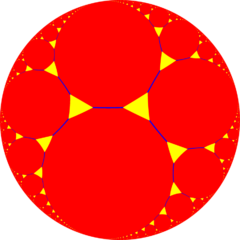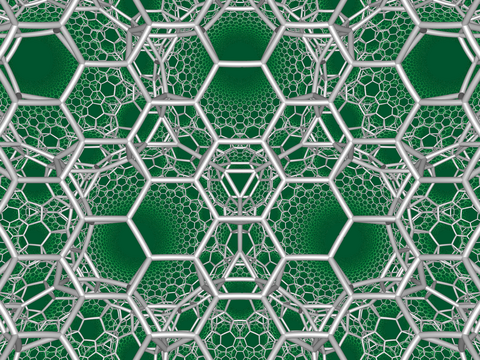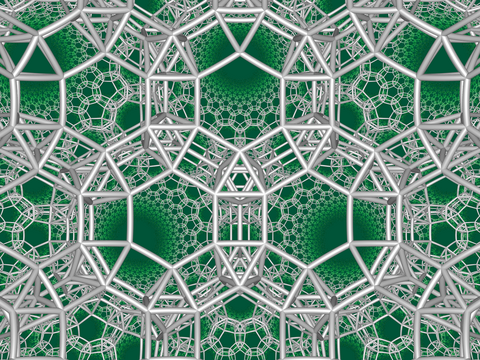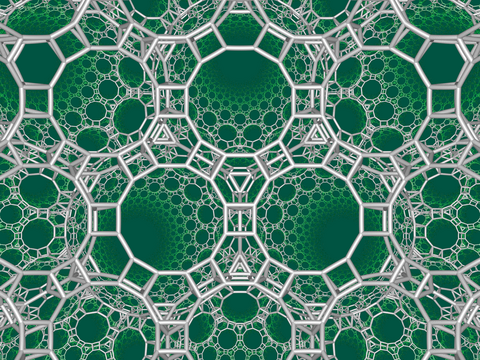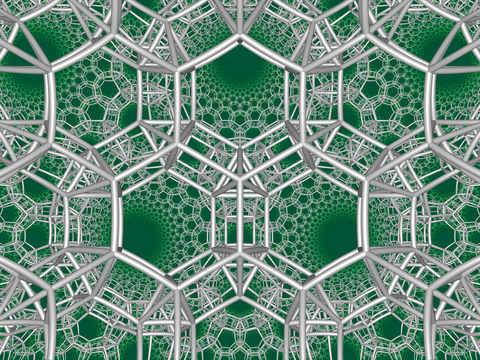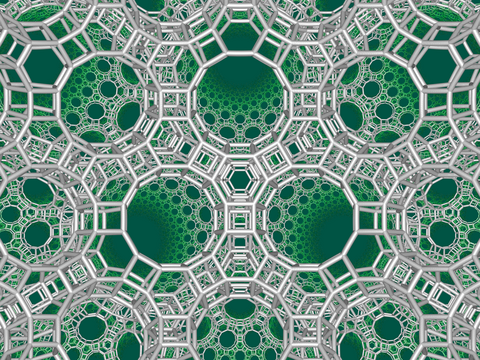Hexagonal tiling honeycomb
| Hexagonal tiling honeycomb | |
|---|---|
 Perspective projection view within Poincaré disk model | |
| Type | Hyperbolic regular honeycomb Paracompact uniform honeycomb |
| Schläfli symbols | {6,3,3} t{3,6,3} 2t{6,3,6} 2t{6,3[3]} t{3[3,3]} |
| Coxeter diagrams | Error creating thumbnail: Unable to save thumbnail to destination Error creating thumbnail: Unable to save thumbnail to destination Error creating thumbnail: Unable to save thumbnail to destination Error creating thumbnail: Unable to save thumbnail to destination Error creating thumbnail: Unable to save thumbnail to destination Error creating thumbnail: Unable to save thumbnail to destination Error creating thumbnail: Unable to save thumbnail to destination Error creating thumbnail: Unable to save thumbnail to destination Error creating thumbnail: Unable to save thumbnail to destination Error creating thumbnail: Unable to save thumbnail to destination Error creating thumbnail: Unable to save thumbnail to destination Error creating thumbnail: Unable to save thumbnail to destination Error creating thumbnail: Unable to save thumbnail to destination Error creating thumbnail: Unable to save thumbnail to destination Error creating thumbnail: Unable to save thumbnail to destination Error creating thumbnail: Unable to save thumbnail to destination Error creating thumbnail: Unable to save thumbnail to destination Error creating thumbnail: Unable to save thumbnail to destination Error creating thumbnail: Unable to save thumbnail to destination Error creating thumbnail: Unable to save thumbnail to destination Error creating thumbnail: Unable to save thumbnail to destination Error creating thumbnail: Unable to save thumbnail to destination Error creating thumbnail: Unable to save thumbnail to destination Error creating thumbnail: Unable to save thumbnail to destination Error creating thumbnail: Unable to save thumbnail to destination Error creating thumbnail: Unable to save thumbnail to destination Error creating thumbnail: Unable to save thumbnail to destination Error creating thumbnail: Unable to save thumbnail to destination Error creating thumbnail: Unable to save thumbnail to destination ↔ Error creating thumbnail: Unable to save thumbnail to destination Error creating thumbnail: Unable to save thumbnail to destination Error creating thumbnail: Unable to save thumbnail to destination Error creating thumbnail: Unable to save thumbnail to destination Error creating thumbnail: Unable to save thumbnail to destination Error creating thumbnail: Unable to save thumbnail to destination Error creating thumbnail: Unable to save thumbnail to destination ↔ Error creating thumbnail: Unable to save thumbnail to destination Error creating thumbnail: Unable to save thumbnail to destination Error creating thumbnail: Unable to save thumbnail to destination Error creating thumbnail: Unable to save thumbnail to destination Error creating thumbnail: Unable to save thumbnail to destination Error creating thumbnail: Unable to save thumbnail to destination Error creating thumbnail: Unable to save thumbnail to destination ↔ Error creating thumbnail: Unable to save thumbnail to destination Error creating thumbnail: Unable to save thumbnail to destination Error creating thumbnail: Unable to save thumbnail to destination Error creating thumbnail: Unable to save thumbnail to destination Error creating thumbnail: Unable to save thumbnail to destination Error creating thumbnail: Unable to save thumbnail to destination Error creating thumbnail: Unable to save thumbnail to destination ↔ Error creating thumbnail: Unable to save thumbnail to destination Error creating thumbnail: Unable to save thumbnail to destination Error creating thumbnail: Unable to save thumbnail to destination Error creating thumbnail: Unable to save thumbnail to destination Error creating thumbnail: Unable to save thumbnail to destination
|
| Cells | {6,3} |
| Faces | hexagon {6} |
| Edge figure | triangle {3} |
| Vertex figure |  tetrahedron {3,3} |
| Dual | Order-6 tetrahedral honeycomb |
| Coxeter groups | [math]\displaystyle{ {\overline{V}}_3 }[/math], [3,3,6] [math]\displaystyle{ {\overline{Y}}_3 }[/math], [3,6,3] [math]\displaystyle{ {\overline{Z}}_3 }[/math], [6,3,6] [math]\displaystyle{ {\overline{VP}}_3 }[/math], [6,3[3]] [math]\displaystyle{ {\overline{PP}}_3 }[/math], [3[3,3]] |
| Properties | Regular |
In the field of hyperbolic geometry, the hexagonal tiling honeycomb is one of 11 regular paracompact honeycombs in 3-dimensional hyperbolic space. It is paracompact because it has cells composed of an infinite number of faces. Each cell is a hexagonal tiling whose vertices lie on a horosphere, a surface in hyperbolic space that approaches a single ideal point at infinity.
The Schläfli symbol of the hexagonal tiling honeycomb is {6,3,3}. Since that of the hexagonal tiling is {6,3}, this honeycomb has three such hexagonal tilings meeting at each edge. Since the Schläfli symbol of the tetrahedron is {3,3}, the vertex figure of this honeycomb is a tetrahedron. Thus, four hexagonal tilings meet at each vertex of this honeycomb, six hexagons meet at each vertex, and four edges meet at each vertex.[1]
Images
Viewed in perspective outside of a Poincaré disk model, the image above shows one hexagonal tiling cell within the honeycomb, and its mid-radius horosphere (the horosphere incident with edge midpoints). In this projection, the hexagons grow infinitely small towards the infinite boundary, asymptoting towards a single ideal point. It can be seen as similar to the order-3 apeirogonal tiling, {∞,3} of H2, with horocycles circumscribing vertices of apeirogonal faces.
| {6,3,3} | {∞,3} |
|---|---|
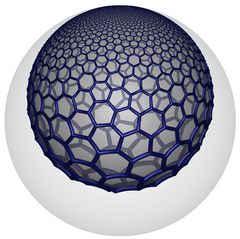
|
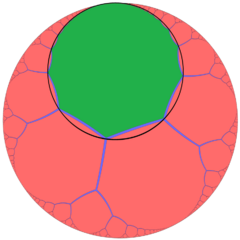
|
| One hexagonal tiling cell of the hexagonal tiling honeycomb | An order-3 apeirogonal tiling with a green apeirogon and its horocycle |
Symmetry constructions
It has a total of five reflectional constructions from five related Coxeter groups all with four mirrors and only the first being regular:
[6,3,3],
[3,6,3],
[6,3,6],
[6,3[3]] and [3[3,3]]
, having 1, 4, 6, 12 and 24 times larger fundamental domains respectively. In Coxeter notation subgroup markups, they are related as: [6,(3,3)*] (remove 3 mirrors, index 24 subgroup); [3,6,3*] or [3*,6,3] (remove 2 mirrors, index 6 subgroup); [1+,6,3,6,1+] (remove two orthogonal mirrors, index 4 subgroup); all of these are isomorphic to [3[3,3]]. The ringed Coxeter diagrams are
,
,
,
and
, representing different types (colors) of hexagonal tilings in the Wythoff construction.
Related polytopes and honeycombs
The hexagonal tiling honeycomb is a regular hyperbolic honeycomb in 3-space, and one of 11 which are paracompact.
It is one of 15 uniform paracompact honeycombs in the [6,3,3] Coxeter group, along with its dual, the order-6 tetrahedral honeycomb.
It is part of a sequence of regular polychora, which include the 5-cell {3,3,3}, tesseract {4,3,3}, and 120-cell {5,3,3} of Euclidean 4-space, along with other hyperbolic honeycombs containing tetrahedral vertex figures. It is also part of a sequence of regular honeycombs of the form {6,3,p}, which are each composed of hexagonal tiling cells:
Rectified hexagonal tiling honeycomb
| Rectified hexagonal tiling honeycomb | |
|---|---|
| Type | Paracompact uniform honeycomb |
| Schläfli symbols | r{6,3,3} or t1{6,3,3} |
| Coxeter diagrams | Error creating thumbnail: Unable to save thumbnail to destination Error creating thumbnail: Unable to save thumbnail to destination Error creating thumbnail: Unable to save thumbnail to destination Error creating thumbnail: Unable to save thumbnail to destination Error creating thumbnail: Unable to save thumbnail to destination Error creating thumbnail: Unable to save thumbnail to destination Error creating thumbnail: Unable to save thumbnail to destination Error creating thumbnail: Unable to save thumbnail to destination Error creating thumbnail: Unable to save thumbnail to destination Error creating thumbnail: Unable to save thumbnail to destination Error creating thumbnail: Unable to save thumbnail to destination Error creating thumbnail: Unable to save thumbnail to destination Error creating thumbnail: Unable to save thumbnail to destination Error creating thumbnail: Unable to save thumbnail to destination ↔ Error creating thumbnail: Unable to save thumbnail to destination Error creating thumbnail: Unable to save thumbnail to destination Error creating thumbnail: Unable to save thumbnail to destination Error creating thumbnail: Unable to save thumbnail to destination Error creating thumbnail: Unable to save thumbnail to destination
|
| Cells | {3,3} r{6,3} 40px or |
| Faces | triangle {3} hexagon {6} |
| Vertex figure |  triangular prism |
| Coxeter groups | [math]\displaystyle{ {\overline{V}}_3 }[/math], [3,3,6] [math]\displaystyle{ {\overline{P}}_3 }[/math], [3,3[3]] |
| Properties | Vertex-transitive, edge-transitive |
The rectified hexagonal tiling honeycomb, t1{6,3,3},
has tetrahedral and trihexagonal tiling facets, with a triangular prism vertex figure. The
half-symmetry construction alternates two types of tetrahedra.
Truncated hexagonal tiling honeycomb
| Truncated hexagonal tiling honeycomb | |
|---|---|
| Type | Paracompact uniform honeycomb |
| Schläfli symbol | t{6,3,3} or t0,1{6,3,3} |
| Coxeter diagram | Error creating thumbnail: Unable to save thumbnail to destination Error creating thumbnail: Unable to save thumbnail to destination Error creating thumbnail: Unable to save thumbnail to destination Error creating thumbnail: Unable to save thumbnail to destination Error creating thumbnail: Unable to save thumbnail to destination Error creating thumbnail: Unable to save thumbnail to destination Error creating thumbnail: Unable to save thumbnail to destination
|
| Cells | {3,3} t{6,3} |
| Faces | triangle {3} dodecagon {12} |
| Vertex figure |  triangular pyramid |
| Coxeter groups | [math]\displaystyle{ {\overline{V}}_3 }[/math], [3,3,6] |
| Properties | Vertex-transitive |
The truncated hexagonal tiling honeycomb, t0,1{6,3,3},
has tetrahedral and truncated hexagonal tiling facets, with a triangular pyramid vertex figure.
It is similar to the 2D hyperbolic truncated order-3 apeirogonal tiling, t{∞,3} with apeirogonal and triangle faces:
Bitruncated hexagonal tiling honeycomb
| Bitruncated hexagonal tiling honeycomb Bitruncated order-6 tetrahedral honeycomb | |
|---|---|
| Type | Paracompact uniform honeycomb |
| Schläfli symbol | 2t{6,3,3} or t1,2{6,3,3} |
| Coxeter diagram | Error creating thumbnail: Unable to save thumbnail to destination Error creating thumbnail: Unable to save thumbnail to destination Error creating thumbnail: Unable to save thumbnail to destination Error creating thumbnail: Unable to save thumbnail to destination Error creating thumbnail: Unable to save thumbnail to destination Error creating thumbnail: Unable to save thumbnail to destination Error creating thumbnail: Unable to save thumbnail to destination Error creating thumbnail: Unable to save thumbnail to destination Error creating thumbnail: Unable to save thumbnail to destination Error creating thumbnail: Unable to save thumbnail to destination Error creating thumbnail: Unable to save thumbnail to destination Error creating thumbnail: Unable to save thumbnail to destination ↔ Error creating thumbnail: Unable to save thumbnail to destination Error creating thumbnail: Unable to save thumbnail to destination Error creating thumbnail: Unable to save thumbnail to destination Error creating thumbnail: Unable to save thumbnail to destination Error creating thumbnail: Unable to save thumbnail to destination Error creating thumbnail: Unable to save thumbnail to destination Error creating thumbnail: Unable to save thumbnail to destination
|
| Cells | t{3,3} t{3,6} |
| Faces | triangle {3} hexagon {6} |
| Vertex figure |  digonal disphenoid |
| Coxeter groups | [math]\displaystyle{ {\overline{V}}_3 }[/math], [3,3,6] [math]\displaystyle{ {\overline{P}}_3 }[/math], [3,3[3]] |
| Properties | Vertex-transitive |
The bitruncated hexagonal tiling honeycomb or bitruncated order-6 tetrahedral honeycomb, t1,2{6,3,3},
has truncated tetrahedron and hexagonal tiling cells, with a digonal disphenoid vertex figure.
Cantellated hexagonal tiling honeycomb
| Cantellated hexagonal tiling honeycomb | |
|---|---|
| Type | Paracompact uniform honeycomb |
| Schläfli symbol | rr{6,3,3} or t0,2{6,3,3} |
| Coxeter diagram | Error creating thumbnail: Unable to save thumbnail to destination Error creating thumbnail: Unable to save thumbnail to destination Error creating thumbnail: Unable to save thumbnail to destination Error creating thumbnail: Unable to save thumbnail to destination Error creating thumbnail: Unable to save thumbnail to destination Error creating thumbnail: Unable to save thumbnail to destination Error creating thumbnail: Unable to save thumbnail to destination
|
| Cells | r{3,3} rr{6,3} 40px {}×{3} |
| Faces | triangle {3} square {4} hexagon {6} |
| Vertex figure |  wedge |
| Coxeter groups | [math]\displaystyle{ {\overline{V}}_3 }[/math], [3,3,6] |
| Properties | Vertex-transitive |
The cantellated hexagonal tiling honeycomb, t0,2{6,3,3},
has octahedron, rhombitrihexagonal tiling, and triangular prism cells, with a wedge vertex figure.
Cantitruncated hexagonal tiling honeycomb
| Cantitruncated hexagonal tiling honeycomb | |
|---|---|
| Type | Paracompact uniform honeycomb |
| Schläfli symbol | tr{6,3,3} or t0,1,2{6,3,3} |
| Coxeter diagram | Error creating thumbnail: Unable to save thumbnail to destination Error creating thumbnail: Unable to save thumbnail to destination Error creating thumbnail: Unable to save thumbnail to destination Error creating thumbnail: Unable to save thumbnail to destination Error creating thumbnail: Unable to save thumbnail to destination Error creating thumbnail: Unable to save thumbnail to destination Error creating thumbnail: Unable to save thumbnail to destination
|
| Cells | t{3,3} tr{6,3} 40px {}×{3} |
| Faces | triangle {3} square {4} hexagon {6} dodecagon {12} |
| Vertex figure |  mirrored sphenoid |
| Coxeter groups | [math]\displaystyle{ {\overline{V}}_3 }[/math], [3,3,6] |
| Properties | Vertex-transitive |
The cantitruncated hexagonal tiling honeycomb, t0,1,2{6,3,3},
has truncated tetrahedron, truncated trihexagonal tiling, and triangular prism cells, with a mirrored sphenoid vertex figure.
Runcinated hexagonal tiling honeycomb
| Runcinated hexagonal tiling honeycomb | |
|---|---|
| Type | Paracompact uniform honeycomb |
| Schläfli symbol | t0,3{6,3,3} |
| Coxeter diagram | Error creating thumbnail: Unable to save thumbnail to destination Error creating thumbnail: Unable to save thumbnail to destination Error creating thumbnail: Unable to save thumbnail to destination Error creating thumbnail: Unable to save thumbnail to destination Error creating thumbnail: Unable to save thumbnail to destination Error creating thumbnail: Unable to save thumbnail to destination Error creating thumbnail: Unable to save thumbnail to destination
|
| Cells | {3,3} {6,3} 40px {}×{6}40px {}×{3} |
| Faces | triangle {3} square {4} hexagon {6} |
| Vertex figure |  irregular triangular antiprism |
| Coxeter groups | [math]\displaystyle{ {\overline{V}}_3 }[/math], [3,3,6] |
| Properties | Vertex-transitive |
The runcinated hexagonal tiling honeycomb, t0,3{6,3,3},
has tetrahedron, hexagonal tiling, hexagonal prism, and triangular prism cells, with an irregular triangular antiprism vertex figure.
Runcitruncated hexagonal tiling honeycomb
| Runcitruncated hexagonal tiling honeycomb | |
|---|---|
| Type | Paracompact uniform honeycomb |
| Schläfli symbol | t0,1,3{6,3,3} |
| Coxeter diagram | Error creating thumbnail: Unable to save thumbnail to destination Error creating thumbnail: Unable to save thumbnail to destination Error creating thumbnail: Unable to save thumbnail to destination Error creating thumbnail: Unable to save thumbnail to destination Error creating thumbnail: Unable to save thumbnail to destination Error creating thumbnail: Unable to save thumbnail to destination Error creating thumbnail: Unable to save thumbnail to destination
|
| Cells | rr{3,3} {}x{3} 40px {}x{12} 40px t{6,3} |
| Faces | triangle {3} square {4} dodecagon {12} |
| Vertex figure | isosceles-trapezoidal pyramid |
| Coxeter groups | [math]\displaystyle{ {\overline{V}}_3 }[/math], [3,3,6] |
| Properties | Vertex-transitive |
The runcitruncated hexagonal tiling honeycomb, t0,1,3{6,3,3},
has cuboctahedron, triangular prism, dodecagonal prism, and truncated hexagonal tiling cells, with an isosceles-trapezoidal pyramid vertex figure.
Runcicantellated hexagonal tiling honeycomb
| Runcicantellated hexagonal tiling honeycomb runcitruncated order-6 tetrahedral honeycomb | |
|---|---|
| Type | Paracompact uniform honeycomb |
| Schläfli symbol | t0,2,3{6,3,3} |
| Coxeter diagram | Error creating thumbnail: Unable to save thumbnail to destination Error creating thumbnail: Unable to save thumbnail to destination Error creating thumbnail: Unable to save thumbnail to destination Error creating thumbnail: Unable to save thumbnail to destination Error creating thumbnail: Unable to save thumbnail to destination Error creating thumbnail: Unable to save thumbnail to destination Error creating thumbnail: Unable to save thumbnail to destination
|
| Cells | t{3,3} {}x{6} 40px rr{6,3} |
| Faces | triangle {3} square {4} hexagon {6} |
| Vertex figure |  isosceles-trapezoidal pyramid |
| Coxeter groups | [math]\displaystyle{ {\overline{V}}_3 }[/math], [3,3,6] |
| Properties | Vertex-transitive |
The runcicantellated hexagonal tiling honeycomb or runcitruncated order-6 tetrahedral honeycomb, t0,2,3{6,3,3},
has truncated tetrahedron, hexagonal prism, and rhombitrihexagonal tiling cells, with an isosceles-trapezoidal pyramid vertex figure.
Omnitruncated hexagonal tiling honeycomb
| Omnitruncated hexagonal tiling honeycomb Omnitruncated order-6 tetrahedral honeycomb | |
|---|---|
| Type | Paracompact uniform honeycomb |
| Schläfli symbol | t0,1,2,3{6,3,3} |
| Coxeter diagram | Error creating thumbnail: Unable to save thumbnail to destination Error creating thumbnail: Unable to save thumbnail to destination Error creating thumbnail: Unable to save thumbnail to destination Error creating thumbnail: Unable to save thumbnail to destination Error creating thumbnail: Unable to save thumbnail to destination Error creating thumbnail: Unable to save thumbnail to destination Error creating thumbnail: Unable to save thumbnail to destination
|
| Cells | tr{3,3} {}x{6} 40px {}x{12} 40px tr{6,3} |
| Faces | square {4} hexagon {6} dodecagon {12} |
| Vertex figure |  irregular tetrahedron |
| Coxeter groups | [math]\displaystyle{ {\overline{V}}_3 }[/math], [3,3,6] |
| Properties | Vertex-transitive |
The omnitruncated hexagonal tiling honeycomb or omnitruncated order-6 tetrahedral honeycomb, t0,1,2,3{6,3,3},
has truncated octahedron, hexagonal prism, dodecagonal prism, and truncated trihexagonal tiling cells, with an irregular tetrahedron vertex figure.
See also
- Convex uniform honeycombs in hyperbolic space
- Regular tessellations of hyperbolic 3-space
- Paracompact uniform honeycombs
- Alternated hexagonal tiling honeycomb
References
- ↑ Coxeter The Beauty of Geometry, 1999, Chapter 10, Table III
- Coxeter, Regular Polytopes, 3rd. ed., Dover Publications, 1973. ISBN:0-486-61480-8. (Tables I and II: Regular polytopes and honeycombs, pp. 294–296)
- The Beauty of Geometry: Twelve Essays (1999), Dover Publications, LCCN 99-35678, ISBN:0-486-40919-8 (Chapter 10, Regular Honeycombs in Hyperbolic Space ) Table III
- Jeffrey R. Weeks The Shape of Space, 2nd edition ISBN:0-8247-0709-5 (Chapters 16–17: Geometries on Three-manifolds I,II)
- N. W. Johnson, R. Kellerhals, J. G. Ratcliffe, S. T. Tschantz, The size of a hyperbolic Coxeter simplex, Transformation Groups (1999), Volume 4, Issue 4, pp 329–353 [1] [2]
- N. W. Johnson, R. Kellerhals, J. G. Ratcliffe, S. T. Tschantz, Commensurability classes of hyperbolic Coxeter groups, (2002) H3: p130. [3]
External links
- John Baez, Visual Insight: {6,3,3} Honeycomb (2014/03/15)
- John Baez, Visual Insight: {6,3,3} Honeycomb in Upper Half Space (2013/09/15)
- John Baez, Visual Insight: Truncated {6,3,3} Honeycomb (2016/12/01)
 |
